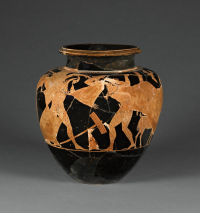



stamnos
An item at Louvre
Decoration: on rim; oves; on belly (at the top); tongues on belly (side A); anodos (remains); satyr (2, headband, loincloth, ithyphallic, brandishing, mallet, on either side of); satyr (headband, loincloth, ithyphallic, dancing, ?, on, mallet) on belly (side B); preparation of the sacrifice; musician (beard, crown: leaf, phorbeia, chiton, holding, aulos, near); young man (crown: leaf, loincloth, leading, ox, near, basin); in the background; man (beard, crown: leaf, himation, holding, stick) above the handle; bird under handle; goat; amphora Condition of the work: incomplete; less than large fragments of the mouth, neck and belly, as well as the foot and handles; the fragment ex Laval RS 466 gives the lower body of the aulete; the fragment J.Paul Getty museum 82 Ae 41 18 gives a part of the female head emerging from the ground face A; 4 fragments in a box. Restoration: glued back together-completed (partially)
Department of Greek, Etruscan and Roman Antiquities
An exhibit at Louvre
The Department of Greek, Etruscan, and Roman Antiquities is home to a collection of artworks representing the Greek, Etruscan, and Roman civilizations; it illustrates the art of a vast area encompassing Greece, Italy, and the whole of the Mediterranean basin, and spans the period from Neolithic times (4th millennium BC) to the 6th century AD.




